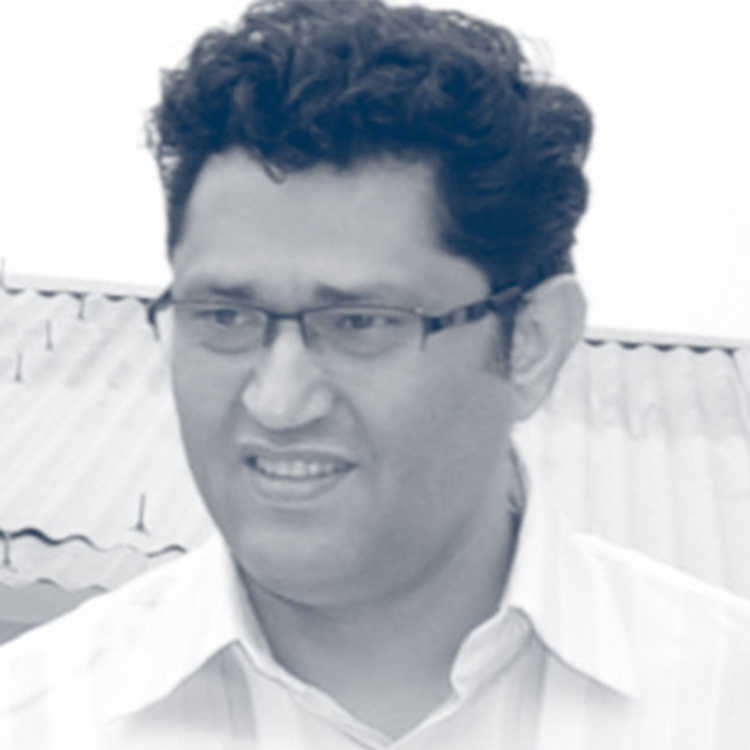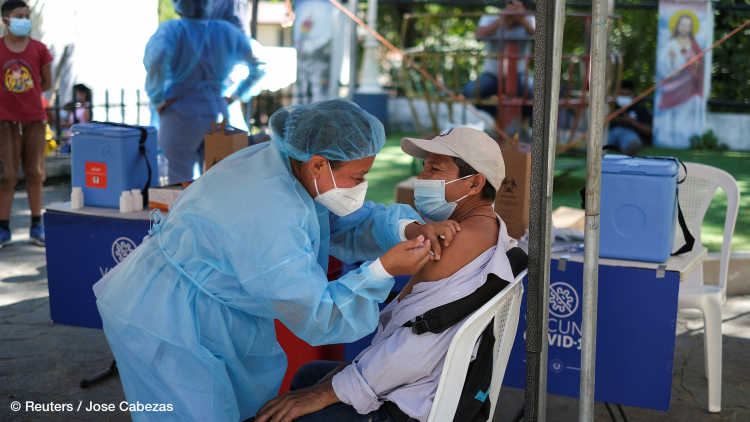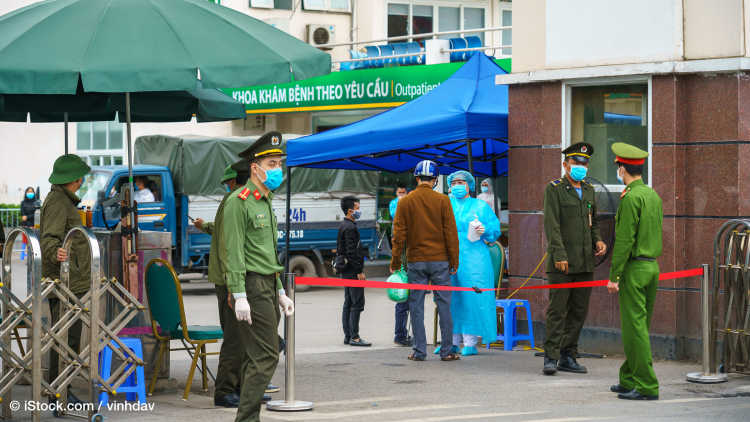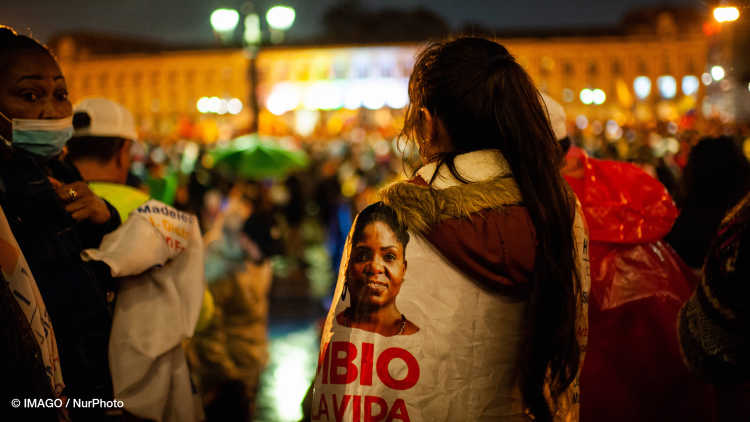- Startseite
- Publikationen
- GIGA Focus
- COVID-19 and Violent Actors in the Global South: A Complex Relationship
GIGA Focus Global
COVID-19 and Violent Actors in the Global South: A Complex Relationship
Nummer 3 | 2022 | ISSN: 1862-3581

Shortly after COVID-19 was classified as a pandemic in March 2020, United Nations Secretary-General António Guterres called on violent actors to initiate ceasefires so that energy could be focused on fighting the pandemic. Resonance was low, however – violence even increased in several countries around the globe. Overall, patterns of violence since the spread of COVID-19 have varied significantly over time, between and within Global South regions, and in terms of the most dominant violent actors.
The nexus of the external shock of COVID-19 and armed violence is multifaceted and its manifestation highly context-specific.
Comparing pre-pandemic patterns of violence with those exhibited in 2020 and 2021 allows us to disentangle pandemic-related from other drivers of violence.
Changes in violence dynamics vary across time and space. While the number and frequency of violent events increased in sub-Saharan Africa after the onset of COVID-19, Latin America and the Caribbean along with the Middle East and North Africa experienced decreases.
State and non-state violent actors were affected differently, and changes in their activities were not always linked to the pandemic per se.
Policy Implications
The main consequences of the COVID-19 pandemic on violence relate to the worsening of structural drivers of violent conflict, such as increasing inequalities and the marginalisation of large segments of the population. Bilateral and multilateral cooperation should focus on policies that reduce inequality and improve the provision of public goods, especially access to food, healthcare, and education. Additionally, “building back better” must include improving political and socio-economic opportunities for women, youth, and ethnic minorities.
External Shocks and Armed Violence
There is broad scholarly debate on the impact of external shocks, such as natural disasters or pandemics, on the dynamics of armed conflict and, relatedly, on the behaviour of specific state and non-state violent actors. Ideal-typically, there are three basic ways external shocks could influence violent actors and their activities: They could have a pacifying effect by engendering a reduction in armed actors’ activities; they could have no significant effect at all; or, they could have an escalating, violence-raising effect by fuelling grievances and exacerbating pre-existing conflicts.
Regarding COVID-19, it is important to highlight that while the pandemic exhibited some initial similarities to short-term exogenous shocks, such as earthquakes or tsunamis, it has also unfolded as a longer-term process – one that might persist for years to come. In this sense, the pandemic is more akin to specific climate phenomena, such as droughts or sea-level rise. A crucial additional aspect is that COVID-19’s reach has been global, its socio-spatial extension much broader and more encompassing than those of most other forms of exogenous shocks. With these features of COVID-19 in mind, the aforementioned ideal-typical ways the pandemic might be linked to the behaviour of violent actors apply as follows, according to extant scholarship and policy analyses.
First, COVID-19 may provide an opportunity for peace – or at least for a reduction of violence – in conflict-prone areas when used to rationalise cooperation. This is what UN Secretary-General António Guterres envisioned with his calls to halt fighting in order to concentrate on containing the pandemic. Yet, the results have been mixed, at best. In some contexts, armed actors have followed Guterres’ call to temporarily lay down their weapons (Bell, Epple, and Pospisil 2020), but overall, pandemic-induced cooperation remained limited. Only 14 countries witnessed ceasefire declarations, many of which were unilaterally declared and not by key actors in the respective conflicts.
Second, COVID-19 may not have any significant effect on the behaviour of violent actors. This lack of effect has manifested mostly in political and socio-economic contexts in which COVID-19 is just one amongst many grave challenges and, therefore, has not been given particular priority. In their preliminary analysis of the first months of 2020, Mehrl and Thurner (2020: 1) suggest that “both the spread of COVID-19 and lockdown policies exhibit a global null effect” on armed conflict.
Third, COVID-19 may lead to an increase in violence in terms of its effects on grievances and opportunity structures. In its end-of-year assessment on “conflicts to watch,” the International Crisis Group (ICG 2021) formulated an explicit warning regarding the medium- and long-term consequences of the pandemic.
Figure 1. Possible Effects of COVID-19 on Violence

Source: Authors’ own representation.
COVID-19 and the enforcement of lockdowns and social distancing also involves a reallocation of resources. The implementation of pandemic-related measures, such as mobility restrictions, necessitates either the direct role of the military, police, and/or other state security institutions, or of non-state armed actors, such as militias or rebels, in the territories under their control. Both state and non-state violent actors can hence use the pandemic to increase their relative control and to potentially garner legitimacy and support.
To disentangle the impact of COVID-19 on violence dynamics, our comparative mapping of large-N data focuses on three major aspects: First, we seek to unravel the temporality of developments, comparing trends within the respective regions and countries of the Global South prior to the pandemic (pre-pandemic conflict patterns) with those occurring over the course of the pandemic. Second, we aim to capture the varying impact of the pandemic on violence across regions. Third, we aim to demonstrate how different state and non-state violent actors increase (or decrease) their activities.
A Cross-Regional Analysis
To map the impact of COVID-19 on conflict dynamics and violent actors in different regions of the Global South – namely, Latin America and the Caribbean (LAC), the Middle East and North Africa (MENA), and sub-Saharan Africa (SSA) – we rely on data from the Armed Conflict Location & Event Data Project (ACLED) (Raleigh et al. 2010). ACLED records information on political violence, demonstrations, and specific non-violent, politically important events. The units of observation are political events. ACLED has an actor-specific focus, as it assigns actors to one of eight different groups: state forces, rebels, political or communal militias, rioters, protesters, civilians, and external actors. Our focus is on those armed actors dominating armed violence in a specific region. While political militias are the most important armed actor in LAC, state violence dominates in MENA. In SSA, we can observe a mix of dominant violence exerted by the state, rebels, and militias.
Globally, violence decreased during the pandemic. However, regional differences can be detected. Whereas LAC and MENA experienced large decreases in violent events and fatalities, mostly driven by changes in regional hotspots such as Syria and Brazil, SSA saw an increase in violence across different actors and countries (see Figure 2).
Figure 2. Weekly Violent Events and Fatalities per Region

Source: Calculation by authors based on data from ACLED.
Examining the temporal dimension, we can observe different trends if we distinguish between an early phase of the pandemic (from March to August 2020) and a longer, mid-term phase (from March 2020 to September 2021). During the initial weeks of the global pandemic in March/April 2020, most states implemented some form of lockdown and social-distancing measures to contain the spread of COVID-19. These regulations impacted the violent dynamics in the regions differently. In LAC and MENA, we observe a decline in violence until initial COVID-related measures were lifted, while in SSA violence increased significantly during the early phase of the pandemic and remained above the pre-pandemic level even after initial measures were lifted.
Figure 3. Change per Actor One Year before vs. One Year after the Pandemic Began

Source: Calculation by authors based on data from ACLED.
When we differentiate by actor type in Figure 3, we observe great variance regarding the most active actors in the three regions. Whereas one actor clearly dominates in each LAC (political militias) and MENA (state organs), three actors (state institutions, rebels, and militias) are almost equally relevant to one another in SSA. This is arguably related to the pluralisation of security provision on the continent. These conflict structures have remained essentially unchanged throughout the pandemic. Changes over time can be attributed to a decrease in the number of events by the most influential actors in LAC and MENA during the pandemic. Contrarily, an increase in the number of violent events in SSA can be observed for all actors during the first year of the pandemic. In other words, the number of conflict events in SSA increased proportionally, reflecting roughly the same differences between the actors as in pre-pandemic times – a marked contrast to other regions.
Violent Actor Dynamics during COVID-19
Given their aforementioned influence on violent dynamics in LAC, MENA, and SSA, our focus is on the three most relevant actors during COVID-19: state actors, rebel groups, and political militias. While we acknowledge the importance of other actor groups for specific regions, such as communal militias for the Sahel or external actors in the wars in Syria, Libya, and Yemen, we will not discuss those here in detail.
State Actors
Armed state institutions are among the most active violent actors in all three regions throughout the pandemic. However, their activities during the pandemic across the regions have been quite heterogeneous. In LAC, almost all states imposed strict lockdown measures during the initial months of the pandemic, leading to an overall decrease in violent clashes between protesters and state actors, though country-specific differences prevailed. In contrast to the overall regional trend, violence against civilians by state actors in Venezuela increased significantly after President Maduro declared a lockdown in March 2020: while the lockdown brought mass demonstrations to a halt, security forces used the measures to suppress smaller civilian actions on several occasions. Venezuela was already experiencing one of the world’s worst humanitarian crises prior to the spread of COVID-19, and food shortages increased drastically during the pandemic. As a result of limited food supply and increasing hunger, spontaneous riots and looting spread across the country during the initial months of the pandemic, which were violently suppressed by the state.
Figure 4. State Violence prior to and during the Pandemic

Source: Calculation by authors based on data from ACLED.
As a whole, the MENA region has experienced the largest decrease in state-related violent events since the beginning of the pandemic, but this reduction in violence has not been evenly spread across the region. The overall violence dynamics in the region have largely been driven by developments in Libya, Syria, and Yemen, each of which is currently at war. Syria is the MENA country with the largest decrease in state-related violent events, which can mostly be traced back to pre-pandemic negotiations and other non–COVID-related changes on the battlefields (see Pavlik 2020). Aside from Syria, major reductions in state-related violent events can be observed in Libya, Turkey, and Yemen, especially regarding direct battle dynamics. Yet, these reductions are mostly not related to COVID-19 and can in part be attributed to increased foreign involvement, such as Turkey’s support of the national government in the Libyan civil war. Outside of these countries, increases in state-based violent events during the pandemic’s first year occurred mostly in the context of mounting repression against protests, the latter of which were often motivated by the worsening economic and social situation. As such, state violence has almost doubled in the Maghreb countries of Algeria, Morocco, and Tunisia.
In strong contrast to the other two regions, state-based violent events in SSA have increased during the pandemic, especially regarding clashes with rebel groups, political militias, and acts of violence against civilians. The increase in clashes with rebel groups stems largely from an increase in attacks by Islamist groups, inter alia in Nigeria. Moreover, violence erupted between state forces and Ambazonian rebel groups in Cameroon, where the former failed to implement a ceasefire agreement during COVID-19. Clashes between state forces and militias increased following a rise in the number of new militia groups and the escalation of existing conflicts – for example, in the Democratic Republic of the Congo (DRC), the Central African Republic, and Mozambique. Yet, except for the violent escalation of conflict between the Ethiopian government and the Tigray People’s Liberation Front into a civil war, the increases in state clashes with political militias have been rather small, suggesting that the pandemic has had a rather limited effect.
SSA has also seen a significant increase in state-based violence against civilians since the very beginning of the pandemic, followed by a quick decline in the subsequent months. Hotspots during the initial phase of the pandemic include countries long known for police violence, such as Nigeria, South Africa, Uganda, and Kenya, but also democratic poster children such as Ghana, with violations reaching from arbitrary arrests to murder. The brutal enforcement of lockdown measures, crackdowns on protests against police violence, and repressive state responses have led to hundreds of arrests and several deaths caused by state forces in several countries in the region throughout the pandemic. On average, state-related violence in SSA has remained higher at any given moment during the pandemic than prior to the spread of COVID-19.
Rebel Groups
Rebel groups play a central role in the violent dynamics in SSA and MENA. However, they are less relevant in LAC, except for in the borderlands between Venezuela and Colombia, and will therefore not be discussed in detail here.
Figure 5. Rebel Violence prior to and during the Pandemic

Source: Calculation by authors based on data from ACLED.
Overall, rebel-based violence in MENA decreased during the pandemic, most notably in Syria due to measures not related to COVID. By contrast, Iraq saw the largest increase in rebel violence one year into the pandemic, which can in part be attributed to a rising number of attacks by the Islamic State in Iraq and al-Sham (ISIS) on military and civilian targets after the declaration of the pandemic, fitting a larger pattern of increased activities by Islamist insurgency groups in the context of the pandemic.
Similar trends can be observed in parts of SSA, which experienced a significant increase in rebel-based violence during the pandemic, largely driven by Islamist groups such as Boko Haram and Al-Shabaab. Both groups attempted to instrumentalise the COVID-19 crisis to ramp up their attacks, while the state also sought to capitalise on the pandemic to fight Islamist insurgents. Besides these insurgencies, violent activities by rebels increased in the separatist conflict in Cameroon and in the eastern DRC, where the Allied Democratic Forces (ADF) stepped up attacks against civilians.
Political Militias
While political militias are still the most dominant violent actors in LAC, their role is comparatively much more limited in both MENA and SSA. While militia activities in the MENA region are concentrated mostly in Yemen, Syria, and Iraq and incorporate both Islamist and non-Islamist, secular-nationalist groups, they are more widespread in SSA, here mostly consisting of Islamist groups. While we observed a reduction in clashes between militias and state actors in MENA, mostly driven by decreases in Syria and Yemen, they sharply increased in SSA. Violent acts against civilians slightly increased in both regions.
Figure 6. Militia Violence prior to and during the Pandemic

Source: Calculation by authors based on data from ACLED.
Despite the prominent status of political militias in LAC, the frequency and lethality of violence by such groups has decreased over the course of the pandemic, especially their violent behaviour towards civilians. Violence against civilians in pre-pandemic times was rather volatile, before decreasing somewhat steadily since the beginning of the pandemic, only to reach pre-pandemic levels by the end of 2020 when several states started to ease their lockdown measures.
There is anecdotal evidence that, during the initial phase of the COVID-19 outbreak, criminal organisations tried to use the pandemic to cement their power in their zones of influence and to increase their acceptance by local populations through the distribution of assistance in the form of food or money, which was often accompanied by a reduction in violence against civilians (Gutierrez, Salguero, and Pfadt 2020). Moreover, local gangs also took over policing duties, enforcing measures such as curfews, which likewise often led to a reduction in violence. Furthermore, given the closure of stores in many countries, extortion rates dropped significantly, particularly in the Northern Triangle (El Salvador, Guatemala, Honduras), where extortion constitutes a primary form of income. However, once lockdown measures were lifted, the numbers started to rise again partly due to gangs trying to collect the extortion money they had suspended due to the lockdown measures. In contrast to the regional trend, violence in Mexico increased in the first month of the pandemic as the reduction in available smuggling routes led to increased competition over territories.
Policy Implications: Focus on Structural Conditions and Vulnerable Groups
Changes over time can be attributed to a decrease in the number of events by the most influential actors in LAC and MENA during the pandemic. For SSA, we observe an increase in the number of violent events for all actors during the first year of the pandemic – from March 2020 to March 2021. In other words, the number of conflict events in SSA increased proportionally, reflecting roughly the same differences between the actors as in the pre-pandemic time – a marked contrast to the other regions.
Our analysis comparing the immediate pre-pandemic time – the year 2019 – and the pandemic’s first 18 months – from spring 2020 and to autumn 2021 – allows us to distinguish short-term effects from potential medium-term consequences. We observe high levels of regional heterogeneity. This was confirmed by a set of qualitative case studies (Bank et al. 2022). In all countries, the COVID-19 pandemic has brought to the fore and/or exacerbated pre-existing structural problems, including a lack of state capacity regarding public service provision in the health sector, a dearth of prospects for youth, and increased levels of socio-economic inequality. Together, these structural conditions make for a toxic mix and a breeding ground for armed actors to flourish and challenge the respective democratic or authoritarian governments. The worst consequences of the pandemic might still be in the making.
As a consequence, policies to contain the pandemic and to “build back better” need to emphasise the aforementioned structural roots of violent conflict: inequality in access to education, dignified work, and livelihoods, in addition to the lack of opportunities for marginalised groups to participate in society and political life. Even where social policies have been put in place, children and youth, as well as women, have had to bear the consequences of closed schools, care work, and other pandemic-related duties and restrictions. Development cooperation should therefore increase its emphasis on policies to create and improve inclusion and equal access to public goods.
Fußnoten
References
Bank, André, Yannick Deepen, Julia Grauvogel, and Sabine Kurtenbach (2022), COVID-19 and Violent Actors in the Global South: An Inter- and Cross-Regional Comparison, GIGA Working Paper, 329, Hamburg: GIGA, accessed 22 August 2022.
Bell, Christine, Tim Epple, and Jan Pospisil (2020), The Impact of COVID-19 on Peace and Transition Processes: Tracking the Trends, Edinburgh: Global Justice Academy, University of Edinburgh, accessed 15 August 2022.
Gutierrez, Andrea, José Salguero, and Franziska Pfadt (2020), Central America and COVID-19: The Pandemic’s Impact on Gang Violence, Armed Conflict Location & Event Data Project, accessed 11 August 2022.
International Crisis Group (2021), 10 Conflicts to Watch in 2022, accessed 15 August 2022.
Mehrl, Marius, and Paul W. Thurner (2020), The Effect of the Covid-19 Pandemic on Global Armed Conflict: Early Evidence, in: Political Studies Review, 13 August.
Pavlik, Melissa (2020), A Great and Sudden Change: The Global Political Violence Landscape before and after the COVID-19 Pandemic, Special Report, accessed 22 August 2022.
Raleigh, Clionadh, Andrew Linke, Håvard Hegre, and Joakim Karlsen (2010), Introducing ACLED: An Armed Conflict Location and Event Dataset: Special Data Feature, in: Journal of Peace Research, 47, 5, 651–660.
Gesamtredaktion GIGA Focus
Redaktion GIGA Focus Global
Lektorat GIGA Focus Global
Forschungsprojekt
Forschungsschwerpunkte
Wie man diesen Artikel zitiert
Deepen, Yannick, André Bank, Julia Grauvogel, und Sabine Kurtenbach (2022), COVID-19 and Violent Actors in the Global South: A Complex Relationship, GIGA Focus Global, 3, Hamburg: German Institute for Global and Area Studies (GIGA), https://doi.org/10.57671/gfgl-22032
Impressum
Der GIGA Focus ist eine Open-Access-Publikation. Sie kann kostenfrei im Internet gelesen und heruntergeladen werden unter www.giga-hamburg.de/de/publikationen/giga-focus und darf gemäß den Bedingungen der Creative-Commons-Lizenz Attribution-No Derivative Works 3.0 frei vervielfältigt, verbreitet und öffentlich zugänglich gemacht werden. Dies umfasst insbesondere: korrekte Angabe der Erstveröffentlichung als GIGA Focus, keine Bearbeitung oder Kürzung.
Das German Institute for Global and Area Studies (GIGA) – Leibniz-Institut für Globale und Regionale Studien in Hamburg gibt Focus-Reihen zu Afrika, Asien, Lateinamerika, Nahost und zu globalen Fragen heraus. Der GIGA Focus wird vom GIGA redaktionell gestaltet. Die vertretenen Auffassungen stellen die der Autorinnen und Autoren und nicht unbedingt die des Instituts dar. Die Verfassenden sind für den Inhalt ihrer Beiträge verantwortlich. Irrtümer und Auslassungen bleiben vorbehalten. Das GIGA und die Autorinnen und Autoren haften nicht für Richtigkeit und Vollständigkeit oder für Konsequenzen, die sich aus der Nutzung der bereitgestellten Informationen ergeben.



























